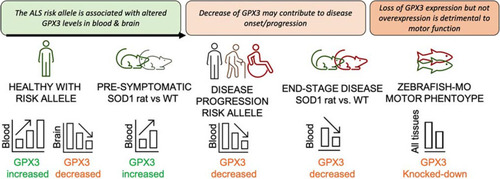Fig. 6
- ID
- ZDB-FIG-220131-26
- Publication
- Restuadi et al., 2022 - Functional characterisation of the amyotrophic lateral sclerosis risk locus GPX3/TNIP1
- Other Figures
- All Figure Page
- Back to All Figure Page
|
Proposed mechanism to explain GPX3 expression with respect to genotype and disease. In healthy individuals carrying an ALS risk allele, GPX3 levels are increased in blood but decreased in the brain compared to non-carriers (SMR from ALS GWAS, eQTLgen n = 31,684 and brain meta-analyses n = 2581). The ALS SOD1H46R rat model [14] shows an increased level of GPX3 compared to wild-type (WT) controls prior to disease onset. This might indicate GPX3 is being secreted into the circulation to support homeostasis/healthy cellular function via antioxidant mechanisms. In disease, cross-sectional analysis of ALS cases, there is reduced expression level with a more progressed disease (Fig. (Fig.4),4), and at end-stage of disease in SOD1H46R rats, GPX3 levels are lower vs. WT controls. Analysis of cross-sectional ALS cases data shows a trend for homozygotes of the risk allele to have lower levels of GPX3 (microarray and protein, p = 0.02 and p = 0.06 respectively, Additional file 2: Figs. S8 and S9). Independently, an in vivo zebrafish-MO model with knockdown of endogenous gpx3 demonstrates a motor phenotype (reduced swimming time, distance, speed) that is rescued with gpx3 expression, to support its essential role in motor function (Fig. (Fig.5),5), while overexpression of variable doses of GPX3 does not result in a motor specific phenotype (Additional file 2: Fig. S14) |

